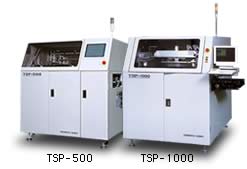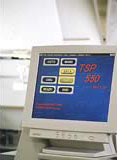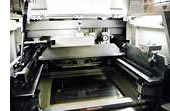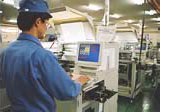
 So far we have put on the market two different types of solder paste screen printing machines: the TSP-500 equipped with a visual recognition apparatus which can be used with the popular M-size PCB (printed circuit board), and the large PCB-compatible TSP-1000. While we were engaged in R&D activities to develop these two types of machine, our customers bombarded us with demands to speed up the printing process in the PCB assembly process "in order to shorten the time required for SMT." It was to comply with those demands that we planned to develop "the world's smallest machine of its kind, equipped with high- performance capabilities and able to carry out printing at high speed." Our R&D effort has resulted in a new solder paste screen printing machine, the TSP-550. At the initial stage of our R&D activities, anxiety was voiced in-house concerning the planned development of the new machine, what with the existing TSP-500 having a proven track record for its stabilized high-performance capability. However, foreseeing the future needs of the market, and in an effort to respond to demands from our customers, we decided to start planning for the development.  One of
the needs of our customers was for us to develop an efficient and effective
way of cleaning sophisticated metal masks used with solder paste screen
printing machines. With these machines, cream solder fills up in metal
masks before being transferred on to PCBs. In order to keep the rate of
transference constant at a high level, it is necessary to clean the metal
masks at regular intervals. Our engineers therefore visited the work site
of each of our customers to study first-hand in what ways and how often
they conduct metal mask cleaning. One of
the needs of our customers was for us to develop an efficient and effective
way of cleaning sophisticated metal masks used with solder paste screen
printing machines. With these machines, cream solder fills up in metal
masks before being transferred on to PCBs. In order to keep the rate of
transference constant at a high level, it is necessary to clean the metal
masks at regular intervals. Our engineers therefore visited the work site
of each of our customers to study first-hand in what ways and how often
they conduct metal mask cleaning.Our efforts have now resulted in the development of what is called an "X-Y"cleaning method, unknown to the trade at that time. This method was proven to allow metal mask cleaning to be carried out in four different directions: i.e., vertically, laterally, rotationally and obliquely. It also enabled the operator to freely change not only the method and frequency of cleaning according to the reciprocating motion of the cleaner, but to select either dry-cleaning or wet-cleaning as well.  This cleaning
method, which was designed to take into consideration the feelings of
operators, made it possible to increase the rate of solder paste transference
and streamline the PCB solder paste screen printing process from the ground
up. This cleaning
method, which was designed to take into consideration the feelings of
operators, made it possible to increase the rate of solder paste transference
and streamline the PCB solder paste screen printing process from the ground
up.
However, it was also found necessary to speed up the printing process itself in order to meet the needs of customers for speeding up tuct times no matter how rapidly and accurately cleaning could be carried out. There was one other problem for which we had to find a solution.  There were
two things we did to solve the problem: one was to combine the camera
and the PCB stopper in one unit and enable the camera to instantly catch
the image of the datum mark on the PCB as it comes into the production
line, while the other was to devise a mechanism that could move incoming
and outgoing PCBs into/out of the printing machine at the same. In addition,
we were able to upgrade the rate of solder transference by leaps and bounds
by further refining our low-pressure squeezing technology. There were
two things we did to solve the problem: one was to combine the camera
and the PCB stopper in one unit and enable the camera to instantly catch
the image of the datum mark on the PCB as it comes into the production
line, while the other was to devise a mechanism that could move incoming
and outgoing PCBs into/out of the printing machine at the same. In addition,
we were able to upgrade the rate of solder transference by leaps and bounds
by further refining our low-pressure squeezing technology.We have thus perfected our visual inspection apparatus-fitted TSP-550 able to carry out solder paste screen printing and machine-cleaning each time printing is conducted. The whole process of printing and cleaning is finished in a total of 20 seconds or less (13.5 seconds for printing and 6.5 seconds for cleaning). What has gained overwhelming support from the users of our new development, which incorporates the above-mentioned high functionality and performance capability that cannot be found in rival machines produced our competitors, is housed in a small machine body no greater than 900mm in width. Our future aim is to develop a solder paste screen printing machine fully loaded with customer-required capabilities and able to produce finer patterns of printing in smaller pitches. |